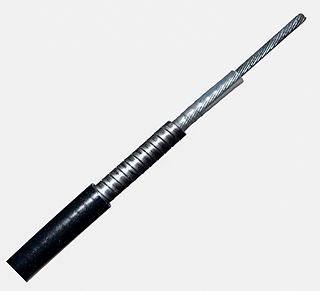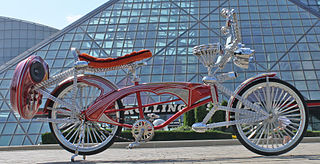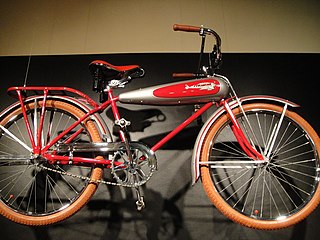Related Research Articles

A bicycle, also called a bike or cycle, is a human-powered or motor-powered, pedal-driven, single-track vehicle, having two wheels attached to a frame, one behind the other. A bicycle rider is called a cyclist, or bicyclist.

Cycling, also called bicycling or biking, is the use of bicycles for transport, recreation, exercise or sport. People engaged in cycling are referred to as "cyclists", "bicyclists", or "bikers". Apart from two-wheeled bicycles, "cycling" also includes the riding of unicycles, tricycles, quadricycles, recumbent and similar human-powered vehicles (HPVs).

The penny-farthing, also known as a high wheel, high wheeler or ordinary, was the first machine to be called a "bicycle". It was popular in the 1870s and 1880s, with its large front wheel providing high speeds and comfort.

A Bowden cable is a type of flexible cable used to transmit mechanical force or energy by the movement of an inner cable relative to a hollow outer cable housing. The housing is generally of composite construction, consisting of an inner lining, a longitudinally incompressible layer such as a helical winding or a sheaf of steel wire, and a protective outer covering.

A velocipede is a human-powered land vehicle with one or more wheels. The most common type of velocipede today is the bicycle.

Vehicles that have two wheels and require balancing by the rider date back to the early 19th century. The first means of transport making use of two wheels arranged consecutively, and thus the archetype of the bicycle, was the German draisine dating back to 1817. The term bicycle was coined in France in the 1860s, and the descriptive title "penny farthing", used to describe an "ordinary bicycle", is a 19th-century term.

Since the advent of the bicycle in the 1860s, Chicago has been distinguished as one of the premier cycling locations in the United States, with such public cycling destinations as Grant Park, Burnham Park and the Chicago Park District's Lakefront Trail.

A lowrider bicycle is a highly customized bicycle with styling inspired by lowrider cars. These bikes often feature a long, curved banana seat with a sissy bar and very tall upward-swept ape hanger handlebars. A lot of chrome, velvet, and overspoked wheels are common accessories to these custom bicycles.

An electric bicycle, also known as an e-bike or ebike, is a bicycle with an integrated electric motor used to assist propulsion. Many kinds of e-bikes are available worldwide, but they generally fall into two broad categories: bikes that assist the rider's pedal-power and bikes that add a throttle, integrating moped-style functionality. Both retain the ability to be pedaled by the rider and are therefore not electric motorcycles.
This timeline of motorized bicycle history is a summary of the major events in the development and use of motorized bicycles and tricycles, which are defined as pedal cycles with motor assistance but which can be powered by pedals alone.

A cruiser bicycle, also known as a beach cruiser or (formerly) motobike, is a bicycle that usually combines balloon tires, an upright seating posture, a single-speed drivetrain, and straightforward steel construction with expressive styling. Cruisers are popular among casual bicyclists and vacationers because they are very stable and easy to ride, but their heavy weight and balloon tires tend to make them rather slow. Another common feature is their ability to be customized with accessories including fenders, lights and saddle bags. They are designed for use primarily on paved roads, moderate speeds/distances, and are included in the non-racing/non-touring class and heavyweight or middleweight styles of the road bicycle type.
Pope Manufacturing Company was founded by Albert Augustus Pope around 1876 in Boston, Massachusetts, and incorporated in Hartford, Connecticut in 1877. Manufacturing of bicycles began in 1878 in Hartford at the Weed Sewing Machine Company factory. Pope manufactured bicycles, motorcycles, and automobiles. From 1905 to 1913, Pope gradually consolidated manufacturing to the Westfield Mass plant. The main offices remained in Hartford. It ceased automobile production in 1915 and ceased motorcycle production in 1918. The company subsequently underwent a variety of changes in form, name and product lines through the intervening years. To this day, bicycles continue to be sold under the Columbia brand.

A belt-driven bicycle is a chainless bicycle that uses a toothed synchronous belt to transmit power from the pedals to the wheel.

Pierre Lallement is considered by some to be the inventor of the pedal bicycle.

The bike boom or bicycle craze is any of several specific historic periods marked by increased bicycle enthusiasm, popularity, and sales.
Dahon is the world's largest manufacturer of folding bicycles with a two-thirds marketshare in 2006. The company was founded in 1982 by David T. Hon, a former laser physicist, and is headquartered in Los Angeles, California, with assembly factories in China, Macau and Bulgaria. Dahon markets bicycles under its own name as well as other brand names, including the affiliated Yeah and Biceco Brands, and Novara for REI in the U.S. The company is a member of the Global Alliance for EcoMobility. Dahon holds over 200 patents, some having become industry standards.

The RevoPower is a motorized wheel concept, the idea being the conversion of a pedal-powered bicycle into a motorcycle. It was invented by Denver, Colorado based RevoPower Inc.

John Thompson Keen was born on 25 February 1849 at Broadway in the county of Worcestershire, England, and lived in Surbiton, Surrey from the age of five. He gained an international reputation both as a professional sports cyclist and a manufacturer of bicycles.

A wheelie bike, also called a dragster, muscle bike, high-riser, spyder bike or banana bike, is a type of stylized children's bicycle designed in the 1960s to resemble a chopper motorcycle and characterized by ape hanger handlebars, a banana seat with sissy bar, and small wheels. Notable examples include the Schwinn Sting-Ray and Krate lines and the Raleigh Chopper line. Other notable manufacturers and retailers that offered models include AMF, CCM, Columbia, Huffy, Iverson, J. C. Penney, Malvern Star, Monark, Murray, Ross, Sears, and Vindec.
A Swing Bike is a brand of bicycle which allowed for steering at both the front wheel and the rear wheel. The design was patented by Ralph Belden in 1974, brought to market in 1975, and discontinued by 1978. The name has come to mean any bike with a second steering axis in front of the saddle. A new bicycle by the same name has been launched by Americas Bike Co. in San Diego, California.
References
- ↑ "US Patent 2601994: Stabilizer for bicycles" . Retrieved 2010-07-01.
- ↑ "1955 Stelber" . Retrieved 2010-07-01.
- ↑ Brett Barris. "George Barris: More Catalog and Promotional Literature For The George Barris Line Of Bicycle Designs Created For The Iverson Division Of Stelber Cycle Corporation" . Retrieved 2010-07-01.
- ↑ What's New: A Picture Roundup of New Products and Developments. Popular Science. September 1972. Retrieved 2010-07-01.